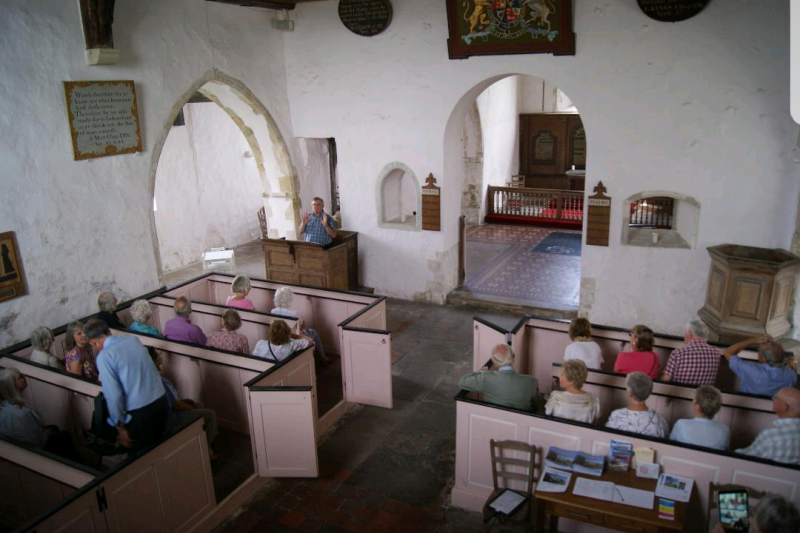Each year the Friends of St Mary’s plan a summer outing to visit two or three churches on or around Romney Marsh and then take tea with the Women’s Institute. This year we visited churches last seen eight years ago. With the weather overcast but warm, 30 Friends met two Rye Community buses at Rye Station Approach on Saturday July 8. Access had been arranged to the ancient churches of East Guldeford, Old Romney and Brenzett.
First stop was East Guldeford, where, as a bonus, we found an art installation symbolising connections. East Guldeford is the only Marsh Church in Sussex and the most recent, as it was opened in 1505 by local squire, Richard Guldeford. Having built it he immediately went on pilgrimage and died in Jerusalem en route. His banner can be seen in the Church.
Next, the group headed across the Marsh to follow the route of the medieval Rhee Wall (actually a ditch which separated Romney Marsh from the sea and later aided the flow from Appledore to the coast) to Old Romney. This provided a wonderfully elevated view of the Marsh sky above fields full of sheep and lambs.
From the newest, we went to one of the oldest Marsh churches: St Clement at Old Romney, which was built on a Saxon mound by the Normans in the 12th century. Up until the great storm of 1287, the Romneys provided access from the Marsh to the sea.
But once the port of Romney was closed by silt during the storm, the river was diverted past Rye to exit at Old Winchelsea. St Clement was much extended in the 13th and 14th centuries by the addition of side aisles, chancel and tower; all buttressed to prevent subsidence on the soft marsh ground. This is a church full of ancient features: squints (in to the Chancel), a medieval doorway which once led to stairs to the Rood Screen; a Purbeck stone altar replaced after removal in the 16th century; probably a crusader’s grave in the Lady Chapel; a lovely Norman font, and pink painted woodwork, a relic of Disney’s Dr Syn filming of 1962, and the grave of film director Derek Jarman.
As we retraced our steps back down the route of the Rhee Wall our next stop was the now little-used church at Brenzett. Unusually for Romney Marsh, it is hidden among trees, but sited close by to the important crossroads. Dedicated to St Eanswith, a Saxon princess, granddaughter of Ethelbert the first Christian King of Kent. In 1381, Brenzett was the rallying place for the followers of peasant revolt leader, Wat Tyler. The manor had once belonged to Thomas Cromwell but in 1541 it passed to the King until 1555, when Queen Mary granted it to Lord Saye. Later the manor, now long gone, was held by several East Kent families, including the Fagges, whose elaborate tomb with 16th-century effigies dominates the northern side chapel.
By now there was some enthusiasm to move on to Stone-cum-Ebony and tea. For those who had experienced a WI tea before there was great expectation of another memorable meal in the wonderful 1914-18 Stone Memorial Hall. On our arrival, the WI team were ready and waiting with long tables set with plates of sandwiches, scones and cakes. There was the specially badged WI china, which added to a very typical English “high tea” setting. After about an hour, there was so much food left that some Friends were seen with small doggy bags to take home. After Stone, the buses threaded their way down in the late afternoon sun back down onto the Military Road and to Rye. This was a most enjoyable afternoon, for which we must thank John Gurney, Gill and Paddy Harvey for making all the logistic arrangements and Rye Community Transport for the safe travel.
Photo: Paddy Harvey



